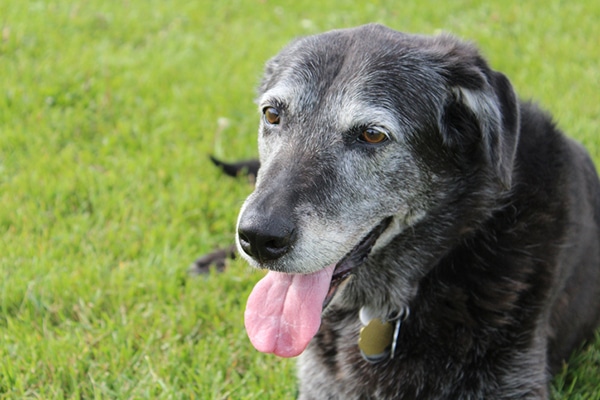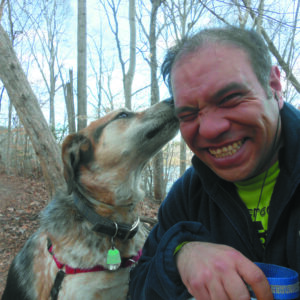What do we mean when we talk about skin tags on dogs? We’re certainly not talking about (nor would we ever advocate) putting a tattoo on your dog, or any other kind of physical graffiti. No, skin tags on dogs are growths that appear on the surface of a dog’s skin. Just like humans, as dogs age their skin exhibits the ravages of time, resulting in skin tags on dogs — and other such growths.
The typical skin tags on dogs start out as small, fleshy growths, resembling warts, any place on a dog’s body, but commonly around the face, legs and belly. Unlike warts, skin tags on dogs tend not to calcify, but rather remain soft and retain the color of the dog’s skin.
While skin tags and surface growths like lipomas typically consist of excess skin or fatty deposits and are normally self-contained, localized and harmless, that does not mean they should be ignored or dismissed. Indeed, any suspicious or random growth has a chance of being cancerous.
Skin tags on dogs are common with advancing age

As dogs reach middle and senior age, their owners should be paying closer attention, especially during normal grooming and bathing, to the external signs of aging. As long as the skin tags are not located in their underarms or around the eyes, where they can irritate or impede a dog’s normal functioning, removal of skin tags on dogs tends to be unnecessary and pursued mainly for aesthetic reasons. The most important thing you can do about skin tags on dogs is to be observant.
If you notice any changes, irritations or abscesses at or around the site of a skin tag, your dog should see a veterinarian to rule out malignant possibilities. Where skin tags on dogs grow out of the surface of the skin and have generally no ill effects, there are a number of other growths that affect dogs as they age.
Lipomas and mast cell tumors, for instance, may resemble skin tags on dogs, but vary in their nature and potential long-term consequences. A quick fine-needle aspiration performed by your veterinarian can tell whether cancerous cells are present, which a biopsy will confirm if true.
Lipomas and other fatty tumors on dogs
So, what are lipomas and fatty tumors — and how are they different from skin tags on dogs? Lipomas are fatty deposits that form just beneath the skin and fur, rather than appearing to grow out of them. Like skin tags on dogs, lipomas tend to stay soft to the touch, and like skin tags on dogs, are usually harmless and painless. That can vary, though, depending on where they form and whether the dog can scratch or bite at them. Lipomas form as the body and its standard filtration systems deteriorate, purging excess toxins through the skin.
The causes of lipomas are varied, but generally contain elements of food preservatives, medications, and other chemicals, such as traces of chlorine found in tap water. As a dog ages, the body’s ability to filter or excrete these unnatural elements in urine, feces, panting or sweating can decline. This decline is expedited if a dog is obese or has pre-existing issues with the kidneys or pancreas.
Foreign chemicals and other such substances are isolated, displaced and stored by the aging canine body in the form of lipomas. Like skin tags on dogs, it is usually unnecessary to have lipomas on dogs removed or treated. Lipomas provide a reliable and otherwise-unavailable service in older dogs, and removing one can lead to others appearing. If a sudden growth appears on or beneath the surface of a dog’s skin, the best thing to do is have it tested by a veterinarian. A confirmation of its nature as a fatty tumor will rule out potential diagnosis of cancer.
Mast cell tumors on dogs
Mast cells are part of the immune system, assisting in defense against allergies and in healing processes. These types of tumors in dogs are one reason why any strange or suddenly appearing skin growth should be tested. Mast cell tumors may be mistaken for lipomas and skin tags on dogs. Like lipomas and skin tags on dogs, mast cell tumors tend to affect mostly older dogs.
Two major differences between lipomas and mast cell tumors are that mast cell tumors can form at any time in a dog’s life and can change size rapidly. Similar to skin tags and lipomas, mast cell tumors can appear anywhere on a dog’s body, but many are found on the lower body, including the genitals, and on the legs.
Another significant difference is that mast cell tumors can be aggressive and spread through the body. Treatments vary depending on the nature of the mast cell tumor and how far it has advanced. Yet another reason to consult a veterinarian at the first sign of a strange growth.
The bottom line on skin tags on dogs and other growths on dogs — stay vigilant as your dog ages!
In my research, I’ve come across a number of home remedies and do-it-yourself solutions for removing skin tags on dogs. I’m a researcher, not a veterinary health specialist, and wouldn’t advise or instruct readers to do anything I wouldn’t be comfortable doing myself. Since skin tags on dogs can be confused with lipomas and mast cell tumors, the first thing you should do is make an appointment with your veterinarian for a proper diagnosis.
Tell us: Have you ever dealt with a skin tag on dogs or other kinds of lumps on dogs? Share your experiences with lumps and skin tags on dogs in the comments.
Plus, concerned about your own skin tags? Read this.
Read more about dog health care on Dogster.com:
- Is Benadryl Safe for Dogs?
- Oils for Dogs: What to Know About Hempseed and Flaxseed Oil for Dogs
- How to Make a Dog Vomit
About the author: Melvin Peña is a writer, editor, and social media manager who spends most of his time in Durham, North Carolina. His interests include his dog, Baby (of course!), art, hiking, urban farming and karaoke.
Featured Image Credit: dageldog | iStock / Getty Images Plus.






